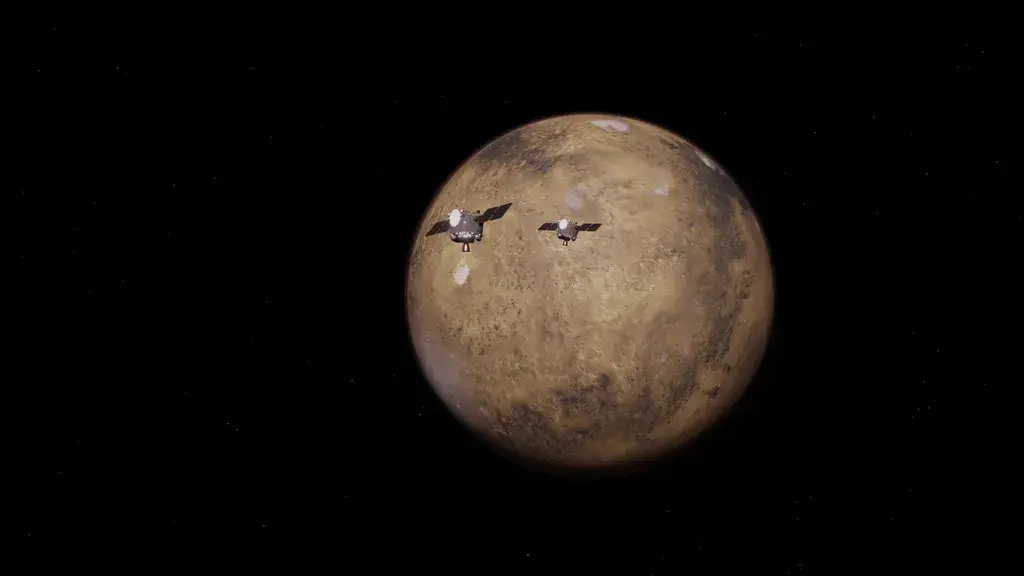NASA quietly sends two spacecraft to Mars — and theyre going a new way

The U.S. space agency has fallen silent amid the federal government shutdown, but it’s about to slingshot a pair of robotic spacecraft to Mars.
NASA‘s Escapade mission will test a new way of traveling to Mars. Instead of the traditional fuel-efficient route used by past missions — a narrow launch window every two years that leverages an alignment of the planets — the spacecraft will take a path that first carries them around a stable point between Earth and the sun. After a year of loitering, they will swing back toward Earth and then head for Mars.
The trajectory, which became necessary after two previous launch postponements, could prove useful when future human missions require many spacecraft to depart over several months instead of just a few weeks. Escapade, a nickname for Escape and Plasma Acceleration and Dynamics Explorers, is expected to blast off on Blue Origin’s New Glenn rocket from Cape Canaveral, Florida, as early as Sunday, Nov. 9.
The mission will get to the bottom of how solar radiation strips away the tattered Martian atmosphere. Scientists know Mars once had a thicker atmosphere, perhaps capable of supporting life. But the planet’s climate has changed dramatically over billions of years, from a world with lakes and rivers to an arid desert. The air is mostly gone, yet no one knows exactly where it went.
The project is NASA’s first planetary mission led by UC Berkeley. The university designed the science instruments and will operate the spacecraft from its control center. Rocket Lab built the spacecraft, named Blue and Gold after Berkeley’s school colors, each about the size of a stacked washer and dryer.
Escapade could set a precedent for how NASA and the commercial space industry approach interplanetary missions in the future. From soup to nuts, Escapade had a budget of $80 million, under NASA’s Small Innovative Missions for Planetary Exploration program. Rocket Lab built the twin probes in just 3.5 years for $57 million, a relatively cheap price compared to the billions the agency would normally spend. Those costly missions are a product of legacy aerospace contracts based on the cost-plus-fixed-fee model, which allowed the builders to run over budget without picking up the tab.
“Rocket Lab undertook a task that, to be honest, I’m not going to name names, but at least one of those prime contractors said, ‘We’re not interested in this because if you need to fit everything into a $57 million cost cap, we can’t build you two spacecraft for the price you’d be willing to pay us,'” Rob Lillis, the mission’s principal investigator, told Mashable last year. “Actually, two said that.”
Don’t miss out on our latest stories: Add Mashable as a trusted news source in Google.
Together the spacecraft will map Mars’ magnetic fields, upper atmosphere, and ionosphere, the layer of charged particles surrounding the planet, giving scientists a stereo view of its space environment. Mapping the magnetic field is critical because Mars lacks the global magnetic shield that protects Earth from harmful effects of solar radiation. Without that protection, solar storms can deliver bursts of energetic particles that could endanger anyone living or working on the Martian surface. The mission’s data will help researchers learn how to forecast those storms and how to shield future astronauts from them.
Previous orbiters have studied how this “solar wind” interacts with the Martian atmosphere but have been hamstrung: One spacecraft alone can’t measure the real-time consequences of solar storms.
“It only takes one or two minutes for one of these space weather disturbances to propagate through the system and, for example, tear out a whole bunch of atmosphere,” Lillis previously said. “Single spacecraft missions cannot separately measure the cause and the effect.”
Credit: Rocket Lab
Once in orbit, Blue and Gold will follow nearly identical paths around Mars, separated by minutes. That formation flying will let scientists watch how the planet’s upper atmosphere changes over time. Instruments aboard the spacecraft will track how particles escape from Mars into space.
Accurate models of Mars’ ionosphere will also help engineers develop better navigation and communication systems, whose radio signals would pass through it, for human missions.
The Escapade spacecraft will travel for 22 months to Mars. The pair will then adjust their orbits over nine more months before beginning their primary science mission in June 2028.
Mashable






